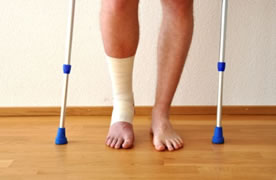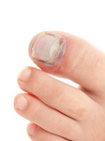Blog
Keon Hatcher Reveals he had Foot Surgery on Social Media
 Keon Hatcher, Arkansas receiver, revealed in a Snapchat video in late April that he had required surgery for his broken foot, which he was the same foot he had broken previously last year. His status at the time was unknown, but Hatcher had broken his foot previously in the Toledo game. He had to have surgery last September, officially ending his season for the year.
Keon Hatcher, Arkansas receiver, revealed in a Snapchat video in late April that he had required surgery for his broken foot, which he was the same foot he had broken previously last year. His status at the time was unknown, but Hatcher had broken his foot previously in the Toledo game. He had to have surgery last September, officially ending his season for the year.
A broken foot requires immediate medical attention and treatment. To learn more, consult with Dr. Michael E. Newman of Pennsylvania. Our doctor will assist you with all of your foot and ankle needs.
Broken Foot Causes, Symptoms, and Treatment
A broken foot is caused by one of the bones in the foot typically breaking when bended, crushed, or stretched beyond its natural capabilities. Usually the location of the fracture indicates how the break occurred, whether it was through an object, fall, or any other type of injury.
Common Symptoms of Broken Feet:
- Bruising
- Pain
- Redness
- Swelling
- Blue (foot)
- Numbness
- Cold
- Misshapen
- Cuts
- Deformities
Those that suspect they have a broken foot shoot seek urgent medical attention where a medical professional could diagnose the severity.
Treatment for broken bones varies depending on the cause, severity and location. Some will require the use of splints, casts or crutches while others could even involve surgery to repair the broken bones. Personal care includes the use of ice and keeping the foot stabilized and elevated.
If you have any questions please feel free to contact our offices located in Plymouth Meeting and Ambler, PA. We offer the newest diagnostic tools and technology to treat your foot and ankle needs.
Treating Your Cracked Heels
 There are many different reasons as to why cracked heels may develop. Cracked heels can become irritated, painful, and itchy, often caused by dry skin, standing for long periods, medical conditions such as athlete’s foot, aging, and other factors. It’s important to treat your cracked heels so they don’t impact your walking or lead to further inflammation or infection. Consider using at-home treatments such as aloe vera, lemons, milk and honey, vinegar, foot ointments, and various oils to soothe your dry skin.
There are many different reasons as to why cracked heels may develop. Cracked heels can become irritated, painful, and itchy, often caused by dry skin, standing for long periods, medical conditions such as athlete’s foot, aging, and other factors. It’s important to treat your cracked heels so they don’t impact your walking or lead to further inflammation or infection. Consider using at-home treatments such as aloe vera, lemons, milk and honey, vinegar, foot ointments, and various oils to soothe your dry skin.
Cracked heels are unsightly and can cause further damage to your shoes and feet. If you have any concerns, consult with Dr. Michael E. Newman of Pennsylvania. Our doctor will assist you with all of your foot and ankle needs.
Cracked Heels
Cracked heels are unappealing, and make it harder for you walk around in sandals. Not only may they look bad, but they can also tear stockings, socks, and wear out your shoes. There are several methods to help restore a cracked heel and prevent further damage.
How do you get them?
Dry skin is the number one culprit in creating cracked heels. Many athletes, walkers, joggers, and even swimmers suffer from cracked heels. Age and skin oil production play a role to getting cracked heels as well.
Promote Healing
Over the counter medicines can help, especially for those that need instant relief, or who suffer from chronic dry feet.
Wear Socks – wearing socks with medicated creams, helps lock in moisture so it can stay on longer.
Moisturizers – applying it both day and night will help alleviate dryness which causes cracking.
Pumice Stones – these remove dead skin, and then you can massage cream onto your foot. This way the cream will be absorbed. The skin needs to be exfoliated; therefore the outer layer dead skin needs removal.
Change in Diet
Eating healthy, with a well-balanced diet, will give the skin a fresh and radiant look. Your body responds to what kinds of food you ingest. Omega-3 fatty acids and zinc supplements will also help with skin tissue.
Most importantly seek a health professional for foot care if something is wrong or doesn’t seem to be working. A podiatrist will help you with any questions or information needed.
If you have any questions please feel free to contact our offices located in Plymouth Meeting and Ambler, PA. We offer the newest diagnostic tools and technology to treat your foot and ankle needs.
Identifying Symptoms of Toenail Fungus
 Also known as onychomycosis, toenail fungus can be an unsightly infection that develops on your toenails, entering into the nail bed and nail plate. Characteristics of toenail fungus include your toenails becoming thick, lacking in shine, brittle, yellow, and separating from the skin. Treatment options for toenail fungus involve topical anti-fungal cream, oral anti-fungal prescription medicine, laser treatment, or surgery to remove the toenail.
Also known as onychomycosis, toenail fungus can be an unsightly infection that develops on your toenails, entering into the nail bed and nail plate. Characteristics of toenail fungus include your toenails becoming thick, lacking in shine, brittle, yellow, and separating from the skin. Treatment options for toenail fungus involve topical anti-fungal cream, oral anti-fungal prescription medicine, laser treatment, or surgery to remove the toenail.
While toenail fungus is troublesome to eradicate, doing so is not impossible. If you have any concerns with your feetconsult with Dr. Michael E. Newman of Pennsylvania. Our doctor will assist you with all of your foot and ankle needs.
Toenail Fungus Treatment
Toenail fungus is a problem which affects many people and is hard to get rid of. Fortunately, there are several methods to go about treating toenail fungus.
Antibiotics & Treatments
Lamisil – is the most commonly effective treatment for toenail fungus. It is available as an antibiotic Terbinafine tablet and cream. Terbinafine is a chemical component which kills fungal growth on the body. Applying regular doses will gradually kill the fungal growth. It is important to keep the area clean and air free.
Talcum powder – applying powder on the feet and shoes helps keep the feet free of moisture and sweat.
Sandals or open toed shoes – wearing these will allow air movement and help keep feet dry. They also expose your feet to light, which fungus cannot tolerate. Socks with moisture wicking material also help as well
Alternative Treatments
There are always surgical procedures that are available for toenail fungus. Some people would like immediate quick removal of toenail fungus. Surgeons will be able to cut through and remove the growth using laser surgery. It is important not to try and remove it yourself. Once removed, your old shoes will need to be replaced to avoid reinfection.
If you have any questions please feel free to contact our offices located in Plymouth Meeting and Ambler, PA. We offer the newest diagnostic tools and technology to treat your foot and ankle needs.
Kate Middleton May Have Hallux Limitus from Prolonged Wearing of High Heels
 Kate Middleton, Duchess of Cambridge, may possibly have hallux limitus, which was discovered when she revealed her bare feet at the Gandhi Smiriti Museum. Podiatrist Charlotte Wood noted that Kate may possibly have hallux rigidus, which can be caused by wearing high heels too much and which leads to pain, swelling, and stiffness. If not treated properly, hallux rigidus can progress into hallux limitus, which means the feet become extremely limited in movement, especially in the big toe joint.
Kate Middleton, Duchess of Cambridge, may possibly have hallux limitus, which was discovered when she revealed her bare feet at the Gandhi Smiriti Museum. Podiatrist Charlotte Wood noted that Kate may possibly have hallux rigidus, which can be caused by wearing high heels too much and which leads to pain, swelling, and stiffness. If not treated properly, hallux rigidus can progress into hallux limitus, which means the feet become extremely limited in movement, especially in the big toe joint.
Hallux limitus is a very uncomfortable condition to live with. If you have any concerns about hallux limitus, consult with Dr. Michael E. Newman of Pennsylvania. Our doctor will assist you with all of your foot and ankle needs.
What You Need To Know About Hallux Limitus
Hallux limitus is a medical condition which stands for “stiff toe.” This is an arthritic condition in which movement of the big toe is constrained. The pain is usually allocated between the large toe and foot. This condition is not of serious matter, but should be treated to avoid a hallux rigdus.
Symptoms
Toe pain is common, therefore many people tend to overlook this issue and believe it’s nothing serious. But, if you notice sharp pain, bone growths, tightness around the joint and even changes in the way you walk. It is vital to see a podiatrist before your condition worsens.
How Do I Get It?
Genetics – hallux limitus can be inherited from your parents, or someone can be who is born with a predisposition to arthritis as well.
Injury – overuse can cause trauma to the joints leading to extra bone growth and wear away the cartilage.
Treatment
X-rays are the most common used methods for diagnosis; it is also performed with a test to see the general function of the big toe.
Lifestyle & Physical Therapy – having motion and massages to the given area will help slow down complications and gradually increase flexibility.
R.I.C.E. – stands for rest, ice, compression and elevation. Combining the R.I.C.E method with other treatments is proven effective.
It is important that when one suffers any kind of foot injury, one should not over exert the toe with strenuous physical activity. Too much activity can destroy the cartilage, making the toe even stiffer.
If you have any questions please feel free to contact our offices located in Plymouth Meeting and Ambler, PA. We offer the newest diagnostic tools and technology to treat your foot and ankle needs.
